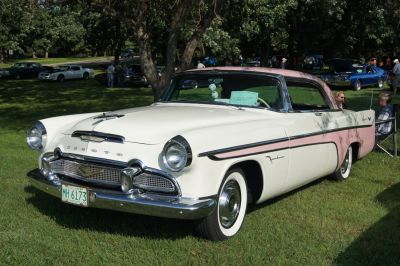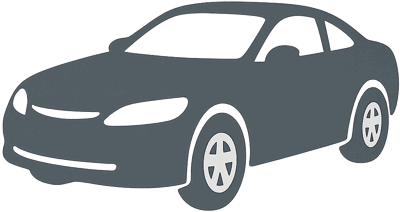 1956 DeSoto Firedome II Two-Door Sportsman (facelift 1956) Dimensions, Size & Specs
1956 DeSoto Firedome II Two-Door Sportsman (facelift 1956) Dimensions, Size & SpecsMeasurements of the 1956 DeSoto Firedome II Two-Door Sportsman, engineered for optimal performance and comfort
| Dimensions | |
|---|---|
| Length: | 5611 mm220.9 in18.4 ft |
| Width: | 1989 mm78.3 in6.5 ft |
| Height: | 1473 mm58.0 in4.8 ft |
The 1956 DeSoto Firedome II Two-Door Sportsman coupe represents a classic American automobile from the mid-1950s, produced between 1955 and 1956. This facelift generation is known for its sleek post-war design, combining elegance with the robust styling cues typical of DeSoto vehicles during that era. Measuring 5611 mm (220.9 inches) in length, the Sportsman coupe commands a notable presence on the road, making it one of the larger coupes of its generation. The width extends to 1989 mm (78.3 inches), providing a roomy cabin and a wide stance that enhances driving stability and road presence. The vehicle stands at a height of 1473 mm (58.0 inches), contributing to its streamlined silhouette while maintaining a comfortable interior headroom. This combination of dimensions underscores the Firedome II Sportsman’s balance of style and practicality, catering to drivers seeking a car that delivers spaciousness without sacrificing sporty coupe aesthetics. As a two-door coupe, the 1956 Firedome II is an important representation of mid-century American automotive culture, blending luxury and performance. Its size and design make it suitable for enthusiasts and collectors interested in classic cars that boast both historical significance and generous proportions. Whether used for cruising or display, the DeSoto Firedome II Two-Door Sportsman stands out as a compelling example of 1950s automotive craftsmanship and design philosophy.
Discover the standout features that make the 1956 DeSoto Firedome II Two-Door Sportsman a leader in its class
Have a question? Please check our knowledgebase first.
The 1956 DeSoto Firedome II Two-Door Sportsman measures 5611 mm (approximately 221 inches or 18.42 feet) in length, 1989 mm (about 78.3 inches or 6.53 feet) in width, and stands 1473 mm (around 58 inches or 4.83 feet) tall. These dimensions contribute to the car's classic elongated coupe silhouette typical of mid-1950s American automobiles, providing a spacious interior while maintaining a sporty coupe profile.
At 1989 mm (around 78.3 inches or 6.53 feet) wide, the 1956 DeSoto Firedome II is relatively wide compared to many modern coupes. This width provides a stable driving experience and a roomy cabin but can pose challenges for parking in tight urban spaces or narrow garages. Drivers should be mindful of curb clearance and side spaces due to the car's broader stance compared to smaller modern vehicles.
The DeSoto Firedome II Two-Door Sportsman from 1956 has a height of 1473 mm (58 inches or 4.83 feet), which is fairly typical for coupes of its era. This relatively low height gives the vehicle a sleek, sporty look with a lower center of gravity, enhancing stability and handling. The car’s height also affects visibility, making it less tall on the road than many modern SUVs or sedans but ensuring a distinct profile.
Most standard residential garages have door openings around 2.13 meters (7 feet) in height and 2.44 meters (8 feet) in width. With a width of 1989 mm (78.3 inches) and a height of 1473 mm (58 inches), the DeSoto Firedome II Two-Door Sportsman fits comfortably within these dimensions. However, the length of 5611 mm (221 inches or over 18 feet) requires sufficient depth inside the garage. Owners should ensure their garage depth can accommodate vehicles exceeding 5.6 meters (18 feet) to avoid any fitment issues.
Compared to its predecessor, the DeSoto Firedome models produced before 1956, the 1956 Firedome II Two-Door Sportsman retained a similar length around 5611 mm (221 inches). While styling and minor dimensions may have shifted due to the facelift, the overall length stayed consistent to preserve interior space and road presence. This length places the Firedome II among the longer coupes of its time, underscoring its emphasis on comfort and style.
When compared to contemporaries such as the 1956 Chevrolet Bel Air Coupe or the Buick Century Coupe, the DeSoto Firedome II's dimensions are competitive and characteristic of full-size American vehicles of its era. Its length of 5611 mm (221 inches) is slightly longer than the Bel Air’s 5600 mm (220.5 inches) and comparable in width around 1989 mm (78.3 inches). This places the Firedome II in the upper range regarding size, offering roomy interiors and substantial road presence.
While exact curb weight for the 1956 Firedome II Two-Door Sportsman is not specified here, similar DeSoto models from the mid-1950s typically weighed between 1700 and 1900 kilograms (approximately 3750 to 4200 pounds). This weight, combined with the large V8 engine typical of Firedome models, provides strong performance but also means fuel consumption would be higher by modern standards. Its weight contributes to a solid feel on the road but requires more power to maintain efficiency.
The 1956 DeSoto Firedome II Two-Door Sportsman typically offers seating for up to six passengers, including the front bench seat common in vehicles of the era. Its considerable exterior dimensions translate into a spacious interior, with generous legroom and headroom for both front and rear passengers. The coupe’s design balances a sporty two-door style with practical comfort, making it suitable for family and social use alike.
The Firedome II Two-Door Sportsman, produced in the 1956 facelift of the Firedome series, featured noticeable styling updates such as revised front grille and trim enhancements that modernized its appeal. Mechanically, it retained the powerful Hemi V8 engine but benefited from improved suspension tuning and chassis refinements for better ride quality and handling. These enhancements refined the experience without drastically altering the successful formula of the earlier Firedome.
Driving the 1956 DeSoto Firedome II Two-Door Sportsman is an experience steeped in the characteristics of classic American cars: larger physical dimensions, heavier weight, and less responsive steering compared to modern vehicles. Its length of over 5.6 meters (18.4 feet) and width close to 2 meters (6.5 feet) mean it demands more attention when maneuvering, especially in tight spaces. While it delivers a smooth ride and strong engine response, parking and low-speed handling require more care than what drivers might be accustomed to in today's compact or mid-sized cars.
Discover similar sized cars.

| Production: | 1955-1956 |
|---|---|
| Model Year: | 1956 |
| Length: | 5611 mm220.9 in |
| Width: | 1989 mm78.3 in |
| Height: | 1473 mm58.0 in |

| Production: | 1955-1956 |
|---|---|
| Model Year: | 1956 |
| Length: | 5611 mm220.9 in |
| Width: | 1989 mm78.3 in |
| Height: | 1473 mm58.0 in |

| Production: | 1955-1956 |
|---|---|
| Model Year: | 1956 |
| Length: | 5611 mm220.9 in |
| Width: | 1989 mm78.3 in |
| Height: | 1473 mm58.0 in |
